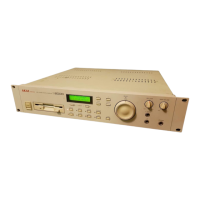MULTI MODE
Page 56 S2000 Operator’s Manual - Version 1.30
To assign the piano to PART 2, flick the outer SELECT wheel to the right - this will select PART
2 and you can use the inner DATA wheel to scroll through the programs until you find one of
the piano sounds you loaded. Now repeat the process, flicking the outer wheel to select PART
3 and the inner DATA wheel to select a bass sound and then flick the outer SELECT wheel
again to select PART 4 and the inner DATA wheel to assign one of the strings programs you
have in memory.
The default MIDI channel assignments are sequential with parts 1-16 using MIDI channels 1-16
so there is nothing to set there (see below for setting a part’s MIDI channel).
Now you have set up a simple multi. You can record your sequence.
MODIFYING THE MULTI
The beauty of the S2000’s MULTI mode is that, as the sequencer is playing back your song,
you can interact with the parts, assigning different programs to parts ‘on the fly’ within the
context of the sequence (you can also edit program parameters such as envelope and filter
settings, etc., within the context of your tune as we shall see later).
So, as the song is playing from the sequencer, you might like to see how PART 2 sounds with
different piano sounds. So, go to the ASSIGN PROG page and, as the sequencer is running,
scroll through the different programs using the inner DATA wheel. You can try alternative piano
sounds and hear how they sound. Do the same for the basses. For example, you may have
loaded some acoustic basses, an electric bass, a slap bass and some synth basses - as the
sequence plays, scroll through them, trying out different ones till you find one that suits the
track. The same, of course, can be done with the string part.
HINT: When loading the programs from disk, try to load certain types together. For example,
load all the piano sounds you think you may need one after another so that they are all
grouped together in memory. Similarly, load all your basses one after another so that these are
all grouped together. This is suggested as it will make selection and comparison of different
sounds in any given part easier.
If you forget to load them in order, don’t worry as you can renumber each program to
something more suitable in SINGLE EDIT mode as we shall see later.
So, to recap, to set up a multi, assuming you have loaded a ‘palette’ of programs that you think
will be suitable for the song you are creating, go to MULTI, press PAGE DOWN and use the
outer SELECT wheel to select the parts and the inner DATA wheel to assign programs to
those parts.

